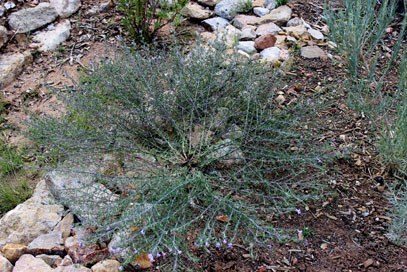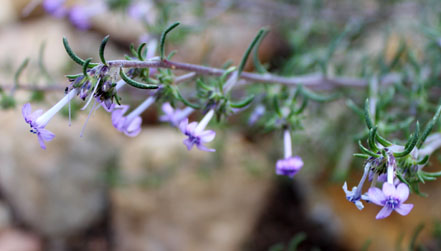The Plant w/Flowers

Flowers

Description
"Duration: Perennial Nativity: Native Lifeform: Subshrub General: Short-lived perennial herb, 15-50 cm tall; stems unbranched or branched at the base, with short to long, glandular to non-glandular hairs. Leaves: Alternate along the stems; blades simple and linear (upper) or pinnately dissected into 3-5 linear lobes (lower), glabrous to sparsely short pilose or glandular. Flowers: Showy and purple, in leafy, diffuse terminal panicles, these often one-sided, with subsessile flowers on short, lateral branches; calyx consisting of 5 glandular-pubescent, awn-tipped sepals, 4-8 mm long, connected to each other by papery membranes; corolla rotate to salverform and 5-lobed, pale violet to purplish, the corolla tube 5-15 mm long and the throat 1-2.5 mm wide, corolla lobes subequal, the lower 3 partly united, often with purple flecks; anthers and stigma exserted beyond corolla. Fruits: Capsule 4-7 mm long, with 2-8 seeds per locule. Ecology: Found in open sites from desert shrublands up into woodlands and in montane forests, from 2,000-8,500 ft (610-2591 m); flowers July-October. Distribution: s CO, AZ, NM; south to n MEX Notes: Often distinguished by its open, diffuse habit, with many little purple flowers. Ethnobotany: Powdered and applied to the face to treat headaches; applied to wounds; and the blossoms were smoked as a pulmonary aid. Also used ceremonially by the Ramah Navajo. Etymology: Ipomopsis means like Ipomoea, the morning glory genus; multiflora means many-flowered." (SEINet)
Internet Resources